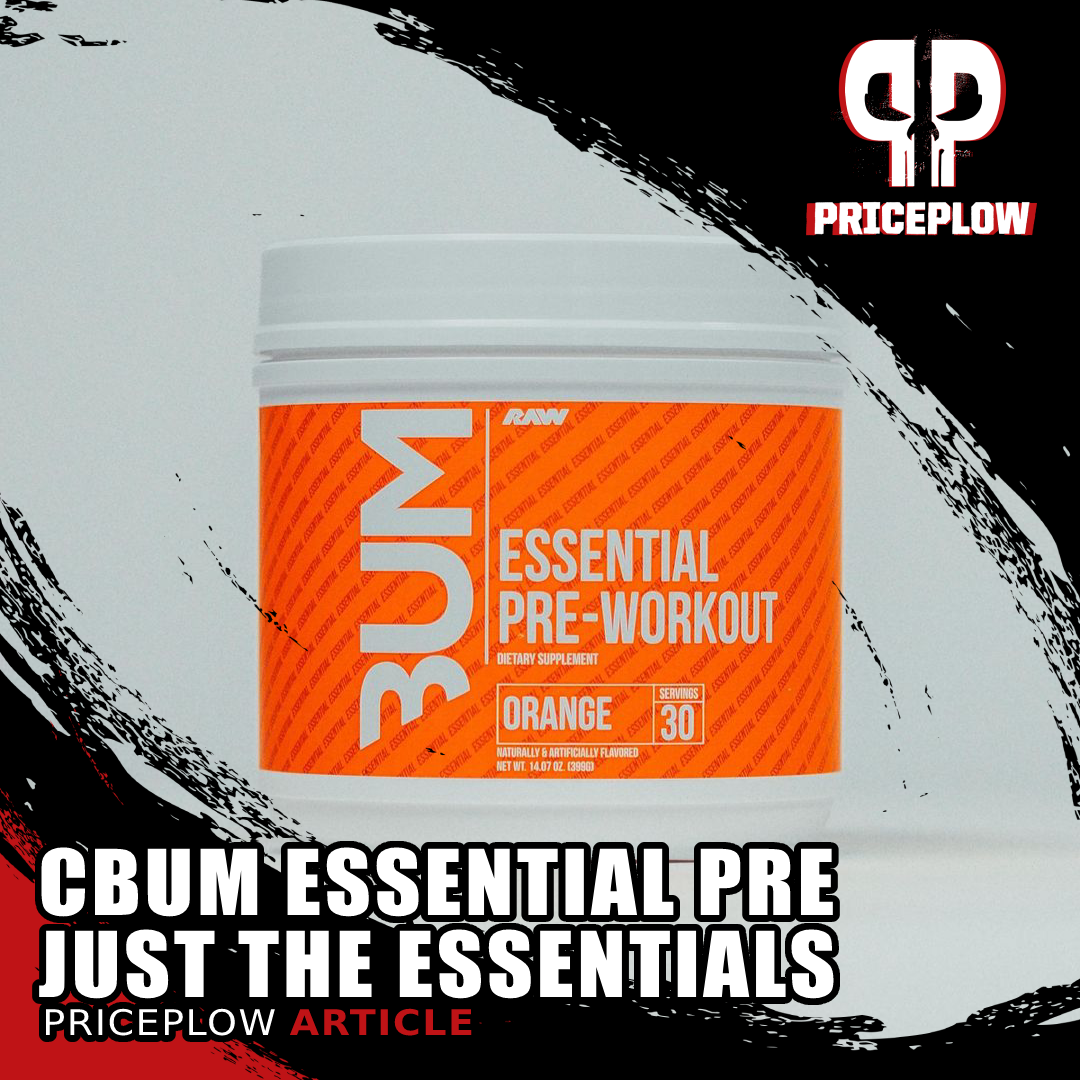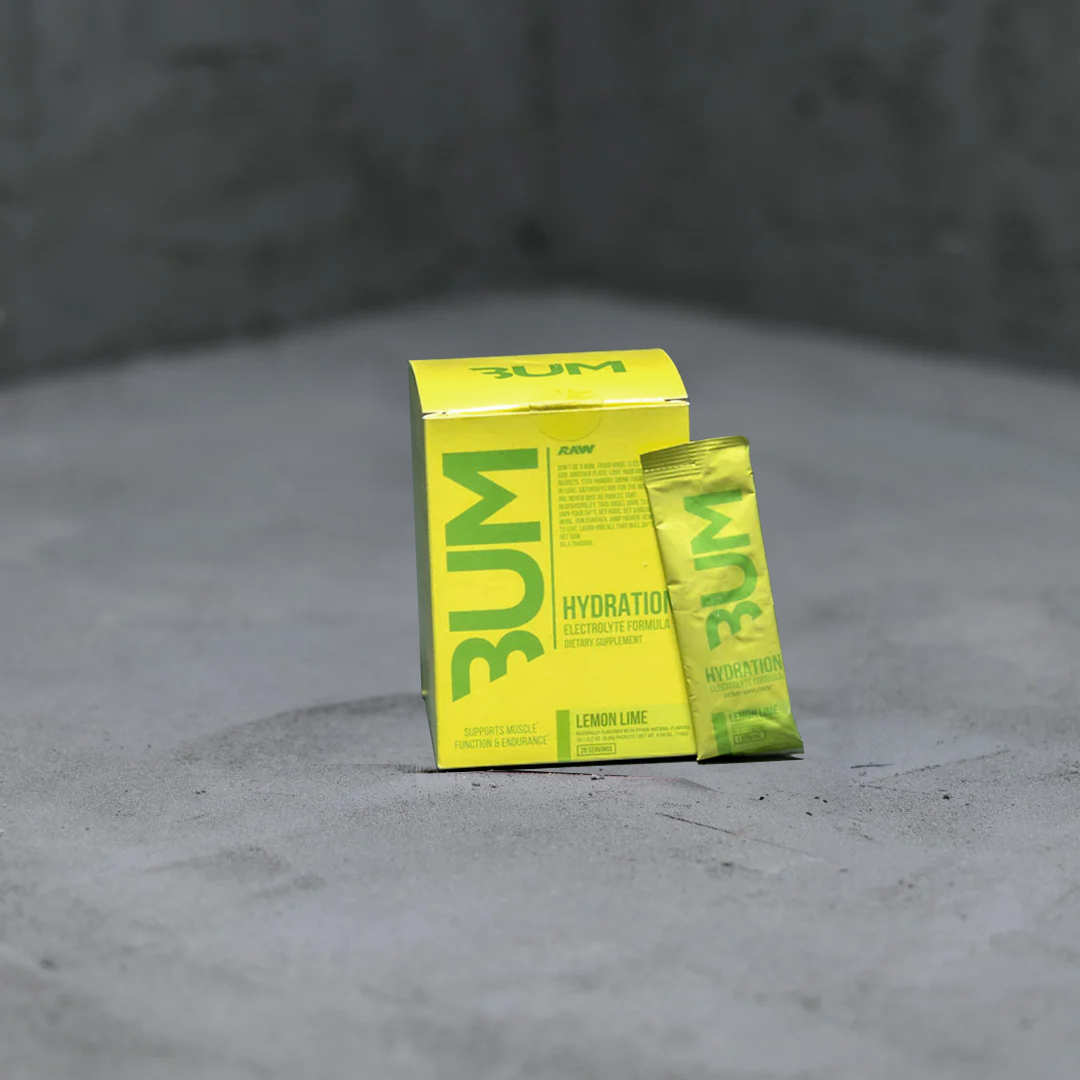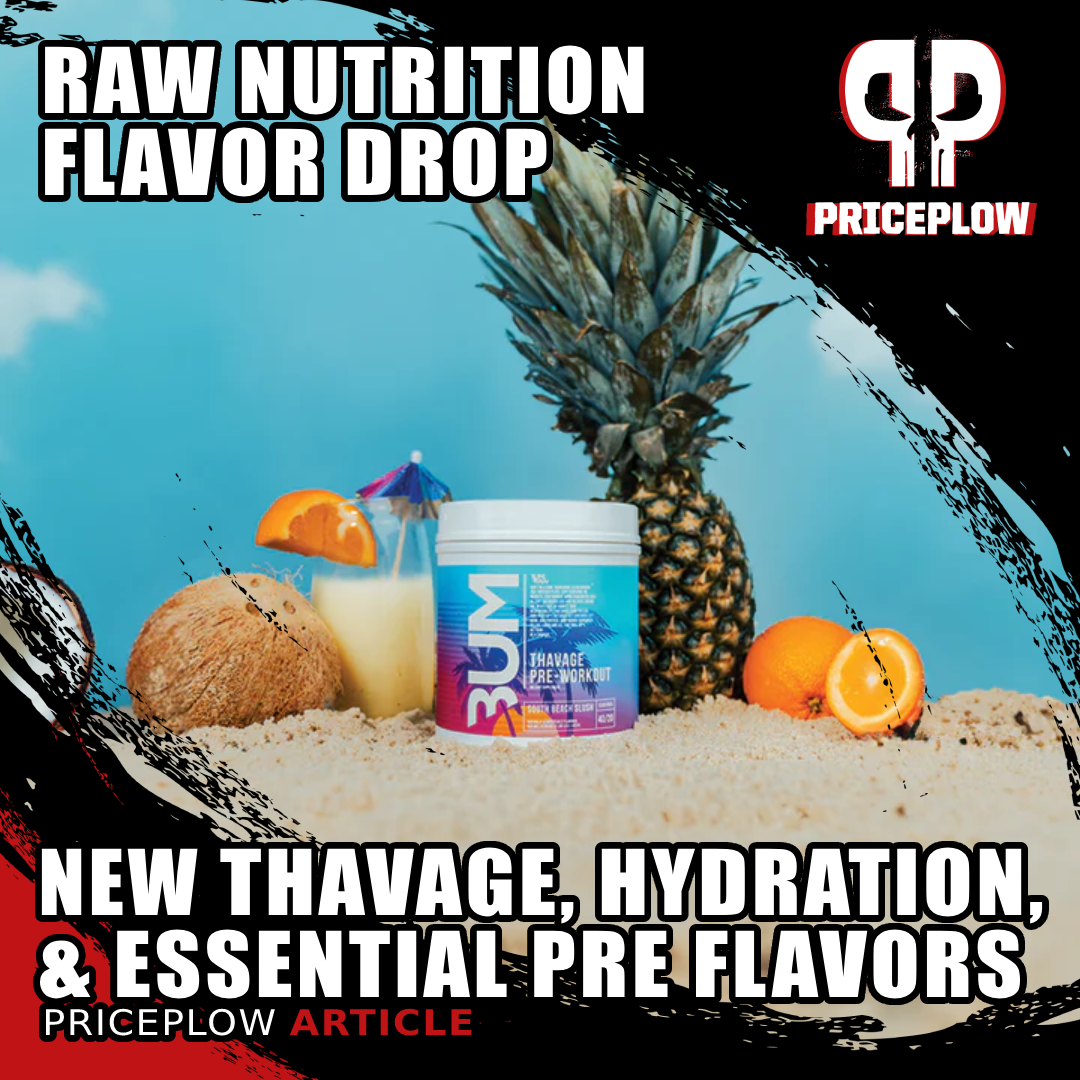RAW Nutrition is a company that has made a name for itself by offering serious products for serious athletes, albeit with a bit of a punk edge, courtesy of the boisterous nature of Chris Bumstead. Whether you're in the market for a protein powder with consistently delicious flavors – as in the case of CBUM Itholate – or looking to turbocharge your workout with Thavage Pre-Workout, RAW has you covered with the purest, most evidence-backed ingredients.
Today, two flavors have been announced for a new supplement in an untouched category for RAW: BUM Hydration, exclusive to Walmart... at least for now.
Refreshing Debut Flavors: Lemon Lime and Fruit Punch
It's easy to overlook hydration as the incredibly important element of health that it is. Now that it's officially the hottest time of the year, staying properly hydrated is vital. As the mercury pushes towards and past that triple digit mark, you'll be losing precious electrolytes through sweating by the ounce.
This applies even more if you're highly active – and if you're in the market for RAW products, odds are you have a pretty stringent workout routine. You can't just take a break because it's a little toasty outside.
To aid in this endeavor, RAW has released two flavors of their new BUM Hydration packs in Lemon Lime and Fruit Punch. Cool and refreshing, these flavors are the ideal duo for the sweltering heat.
We're going to dive into a little summary on how RAW BUM Hydration works, but first, let's check the PricePlow for good RAW BUM deals, and check out our video review of the new flavor:
RAW Nutrition CBUM Hydration Electrolyte Formula – Deals and Price Drop Alerts
Get Price Alerts
No spam, no scams.
Disclosure: PricePlow relies on pricing from stores with which we have a business relationship. We work hard to keep pricing current, but you may find a better offer.
Posts are sponsored in part by the retailers and/or brands listed on this page.
This area is reserved for Team PricePlow's upcoming videos.
Subscribe to our channel and sign up for notifications so you catch it when it goes live!
RAW Nutrition BUM Hydration Ingredients
BUM Hydration is packed with many minerals your body needs to stay fully satiated. Here are the ingredients:
-
Sodium (from Sodium Citrate) - 230mg (10% DV)
Sodium is a key ingredient present in nearly every hydration formula, and its widespread inclusion is backed by solid reasons. It commands its place in the realm of hydration, assuming a pivotal role in maintaining the delicate balance of fluids within and around cells.[1] It serves as a foundational element crucial for muscle movement and plays a vital role in facilitating nerve signal transmission.
Relying solely on water after intense training poses a risk of sodium depletion for athletes, leading to complications like cramps, diminished performance, and, in severe cases, hyponatremia.[2] This is why we love to see this ingredient here.
Sodium Intake: Guiding Athletes
The general guideline for daily sodium intake typically revolves around 2 grams, equivalent to a teaspoon of table salt.[3] However, athletes engaged in rigorous training often find their sodium requirements elevated. In response to this heightened demand, BUM's Hydration proudly presents a substantial 230 milligram (10% Daily Value) of sodium, sourced from sodium citrate.
Sodium Citrate's Performance Impact
What sets BUM Hydration apart is not just the quantity of sodium but the strategic choice of sodium citrate as its source. This decision is crafted to offer a sodium option with lower chloride content.[4] It's an approach that caters to the preferences and considerations of specific individuals, acknowledging the diverse needs within the athletic community.
A study conducted on elite athletes provides insight into the positive impact of a higher sodium citrate dose, notably observed in a timed 3000-meter race. This research highlights the potential advantages that athletes can unlock by opting for sodium citrate over the conventional sodium chloride, emphasizing the performance benefits of this thoughtful formulation.[5]
Extended Workouts: The Need for Sodium Adjustment
As athletes extend their workouts, careful consideration of slightly increased sodium intake becomes more and more relevant. It becomes especially crucial when athletes experience notable sodium losses, such as 3 to 4 grams, serving as a preemptive measure against potential dehydration-related issues.[6]
In simpler terms, sodium emerges not just as a replenishment necessity for athletes but as a key mineral, actively contributing to enhanced performance, quicker recovery, and overall fitness. Athletes committed to optimizing their performance and overall well-being must not fear the sodium.
-
Potassium (from Potassium Citrate and Dipotassium Phosphate) - 175 mg (4% DV)
If you've seen sodium on a hydration label, you'll most likely see some form of potassium paired along with it. In the domain of athletic hydration, the intentional inclusion of potassium in products like BUM Hydration assumes an important role in striking a delicate balance with sodium. This duo is indispensable for providing cardiovascular support and enhancing blood flow through the process of vasodilation.[7-9]
Potassium's Vasodilatory Power
It's been a big day for CBum and Raw! See the CBum Essential Pre-Workout
From an athletic perspective, potassium's role in supporting vasodilation proves crucial. This physiological process, widening blood vessels for enhanced blood flow, stands as a more effective strategy in addressing high blood pressure than a sole focus on sodium restriction. The deliberate combination of potassium and sodium in BUM Hydration reflects a strategic approach to maintaining electrolyte balance.[10,11]
Mechanistically, potassium facilitates vasodilation by hyperpolarizing endothelial cells, effectively reducing blood pressure through the stimulation of the sodium pump and the opening of potassium channels. BUM Hydration, which incorporates potassium, magnesium, and sodium, all bound to citrate, adopts a holistic approach tailored to the specific hydration needs of athletes.[10,11]
Potassium's Shortfall: A Nutritional Gap
Potassium, often overshadowed in Western diets, emerges as a shortfall nutrient, with individuals frequently falling short in consuming potassium-rich foods.[12-15] This is due to nutritional value changes that have caused foods to steer away from including the mineral. The repercussions of an imbalanced sodium-potassium ratio can lead to severe health problems, reinforcing the argument that potassium supplementation, rather than strictly restricting sodium, offers substantial cardiovascular benefits.[7,10,16-19]
This paper's title is so spectacular that it deserves its own call-out.[20] So what gives? We simultaneously believe that sodium recommendations can go higher, but potassium does need to be supplemented in modern dieters as well.
The Potassium Advantage
Research highlights the pivotal role of potassium in cardiovascular health, emphasizing the superiority of higher potassium: sodium intake ratios in reducing blood pressure and the risk of heart disease compared to a singular focus on sodium.[10-12] While there may be limited performance-based research on potassium, anecdotal evidence from team PricePlow and the PricePlow Discord suggests that athletes experience heightened energy levels and endurance with proper hydration that prioritizes potassium.[21,22] BUM Hydration, thoughtfully formulated with 175 milligrams (4% DV) of potassium (from Potassium Citrate and Dipotassium Phosphate), aligns seamlessly with this approach.
-
Magnesium (from Magnesium Bisglycinate Chelate) - 30 mg (7% DV)
Now, let's shine a spotlight on magnesium in BUM Hydration. It's the quiet achiever that doesn't get the applause it deserves but plays a starring role in the whole mix. The research backs it up, showing magnesium's involvement in muscle function, nerve transmission, and energy production.[7-9] Athletes may also feel the difference – more energy, better endurance – all thanks to keeping that magnesium intake on point.[15,23]
Magnesium's Holistic Impact and Cofactor Role
Beyond its role in energy metabolism, magnesium takes an active part in fostering cardiovascular health, establishing a dynamic partnership with potassium to regulate blood pressure levels optimally.[10-12] This strategic collaboration of electrolytes exemplifies the meticulous approach employed in crafting BUM Hydration, aiming for a holistic impact on the body's vital functions.
Diving into the mechanistic aspects, magnesium emerges as a cornerstone, serving as a cofactor in enzymatic reactions pivotal for energy production.[7-9] For athletes striving to reach their pinnacle of performance, magnesium is indispensable. BUM Hydration strategically incorporates magnesium bisglycinate chelate, a carefully selected form prioritizing high bioavailability, which ensures optimal absorption and utilization by the body. The glycine it's bound to may help as well!
Dietary Challenges
Navigating the terrain of magnesium intake presents challenges similar to those encountered with potassium. Despite the availability of magnesium-rich foods, the contemporary shift toward processed dietary choices often leaves individuals with insufficient magnesium levels.[24] Recognizing this dietary gap, supplementation emerges as a practical solution, particularly for individuals engaged in intense physical activities where the demand for magnesium is heightened.
-
Calcium (from Calcium Citrate) - 40mg (3% DV)
If you've spent any time with The PricePlow community, you know we're not too concerned with calcium supplementation, especially if you use dairy and/or take whey. However, it's worth mentioning that it is a player in keeping your heart beating, blood pressure in check, and energy metabolism running smoothly.[25]
-
Zinc (from Zinc Citrate) - 2 mg (18% DV)
This essential mineral isn't just about immune support; it plays a crucial role in cellular energy production, DNA synthesis, protein synthesis, and cell division.[26] Zinc acts as a powerful antioxidant, providing protection for your eyes against potential damage.[26] For those aiming to enhance and sustain their gym performance, zinc emerges as a master mineral for the male endocrine system, playing a pivotal role in optimal testosterone production.[27]
While the product contributes to overall zinc intake, it's advisable to consider additional dietary and supplemental sources for immune system benefits highlighted in the research.
-
Taurine - 1 g
Taurine is a fan-favorite, endurance-boosting compound with multifaceted benefits for athletes and lifters alike. Acting as an osmolyte, taurine plays a pivotal role in maintaining healthy fluid and water balance between cells, contributing to overall cellular well-being.[28]
Endurance Amplified
This amino acid is ubiquitously distributed in various tissues, where it serves as an aide in reducing oxidative stress, stabilizing cell membranes, and supporting calcium signaling crucial for muscular contractions.[28,29] Taurine's impact on endurance is noteworthy, as evidenced by a 2018 meta-analysis highlighting its ability to significantly improve endurance at doses ranging from 1 to 6 grams, even on the first use.[29]
Taurine's Cellular Power Play
Beyond its direct impact on endurance, taurine emerges as a key support ingredient for mitochondrial health. Mitochondria, often referred to as the cellular powerhouses, benefit extensively from taurine support.[30] Aiding in neuroprotection, taurine contributes to synaptic function by mitigating neurological inflammation and enhancing GABA receptor function. Notably, it also lends its support to nitric oxide production, promoting improved blood flow—a critical factor for athletes seeking enhanced performance.[31]
Taurine is categorized as a conditionally essential amino acid, indicating that while the body can produce it internally, supplementation often proves beneficial. This characteristic has led to its widespread inclusion in various supplements, particularly those targeting pre-workout and hydration needs.
Its role in cell volumization pumps and the promotion of osmotic swelling reinforces its significance in hydration supplements. With 1 gram of taurine, this capitalizes on this osmolytic ingredient's ability to increase water retention within cells, fostering osmotic swelling and protecting mitochondria from stress.[30] The notable dose of taurine in BUM Hydration aligns with its emphasis on promoting endurance and supporting overall cellular health.
Taurine's Influence on Concentration
Taurine helps with concentration by contributing to the improvement of nitric oxide production.[32] This helps concentration by allowing the walls of the blood vessels to be more relaxed making it easier for nutrients to flow to your brain and throughout your body. And for lifters, that means a better "pump" effect, which is always a win!
Chris has been Busy - Check out Raw Nutrition's Fall 2023 Flavor Drop!
Moreover, taurine's influence on lipid absorption through its mitochondrial benefits showcases its comprehensive impact on various physiological processes.[30] It goes the extra mile, making sure your concentration and cognition levels are on point, all while keeping the blood and water flowing smoothly to your brain.
With all the benefits of Taurine, it's clear as to why they decided to include it here.
-
Coconut Fruit Water Powder - 500 mg
Coconut water powder is the dried, concentrated form of pure coconut water. It brings a burst of flavor and a touch of potassium to BUM Hydration.[33] Studies highlight its effectiveness in restoring hydration within two hours, surpassing sports drinks when sodium-enhanced, and offering a sweeter and more easily consumable alternative.[33,34] This is especially important in a hydration drink because it makes the drinking process much more enjoyable. It's nice to see coconut water powder in here to give it a flavor boost.
This natural source of electrolytes plays a crucial role in maintaining electrical neutrality in cells, generating action potentials in nerves and muscles.[35] The inclusion of coconut fruit water powder in BUM Hydration caters to the body's post-workout electrolyte needs, offering a dual-purpose ingredient that enhances both flavor and recovery.[33,34]
Why are electrolytes so important?
The significance of very low levels of electrolytes becomes even more apparent when considering the potential consequences — health and performance impairment, and in extreme cases, a life-threatening impact.[36] The absence of adequate electrolytes can lead to severe issues such as cardiac arrhythmia, where the heart's electrical potentials drop, risking a halt in its beating.[37]
Raw Nutrition Signal is an efficacious combo of longjack and fadogia, two popular testosterone-boosting herbs!
This is why there's such a large emphasis on electrolytes in nearly every sports drink on the market today.
-
Added Vitamins
To complete this comprehensive ingredient list, BUM Hydration also incorporates essential vitamins:
- Vitamin C (as Ascorbic Acid) - 50 mg (56% DV) According to numerous studies, vitamin C is renowned for its potent antioxidant properties that combat free radicals and mitigate oxidative damage.[38,39] Beyond being a well-established immune booster,[40] it actively contributes to the supplement's holistic approach by supporting nitric oxide production[41], preventing deficiencies that could impede athletic performance, and enhancing endurance, particularly for those on calorie-reduced diets.[41-43]
- Vitamin B6 (as Pyridoxine HCl) - 1 mg (59% DV) Vitamin B6 plays a role in supporting cellular energy production and metabolism by facilitating the production of essential coenzymes, according to scientific studies. For athletes, this is particularly noteworthy as it contributes to the optimization of energy utilization, potentially enhancing endurance and overall athletic performance.[44]
-
Vitamin B12 (as Methylcobalamin) - 1 mcg (42% DV) Vitamin B12 supports neurological and cognitive function while contributing to overall metabolism. For athletes, this dual functionality is particularly relevant, potentially aiding in mental acuity and ensuring efficient energy metabolism during physical exertion.[45-47]
All RAW BUM Hydration flavors
Check out our up-to-date list of BUM Hydration flavors below:
Good Flavors: Key To Adherence

Also available now in Walmart, CBUM Essential Pre
RAW could not have chosen a better time to drop BUM Hydration Lemon Lime and Fruit Punch. Launched in the middle of another round of heat in the summer of 2023, it's just what Walmart needed. If you're not staying hydrated, you could get sluggish and just feel like laying on the couch.
Since we're not huge fans of laying on the couch, we need to make sure to replenish our stores of the critical vitamins and nutrients required to keep our whole body ticking.
With scientifically-backed dosages of minerals like sodium, potassium, and calcium, we'll be back and ready to hit another set in no time.
Now the only question is, what pre-workout do you choose? Thavage, or CBum Essential Pre?
RAW Nutrition CBUM Hydration Electrolyte Formula – Deals and Price Drop Alerts
Get Price Alerts
No spam, no scams.
Disclosure: PricePlow relies on pricing from stores with which we have a business relationship. We work hard to keep pricing current, but you may find a better offer.
Posts are sponsored in part by the retailers and/or brands listed on this page.













Comments and Discussion (Powered by the PricePlow Forum)